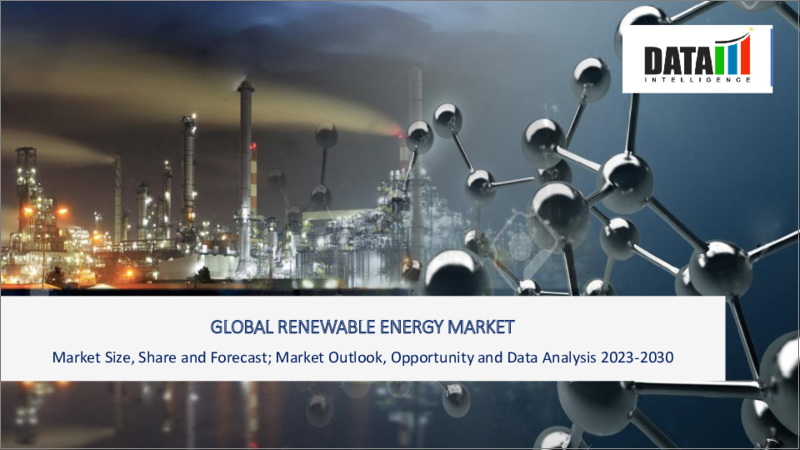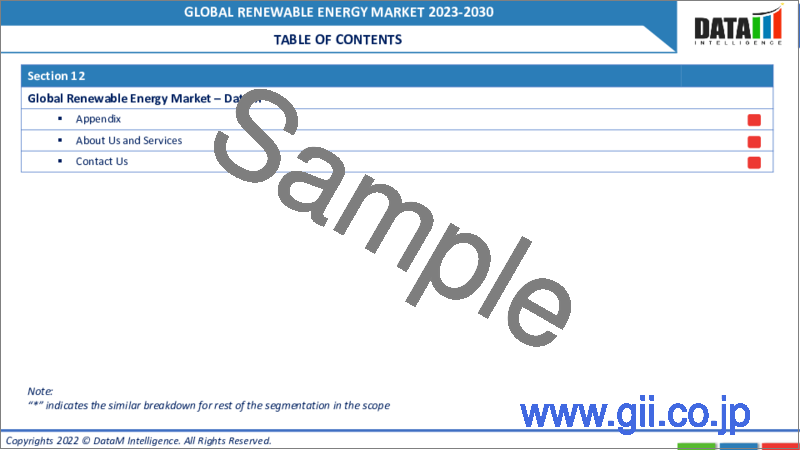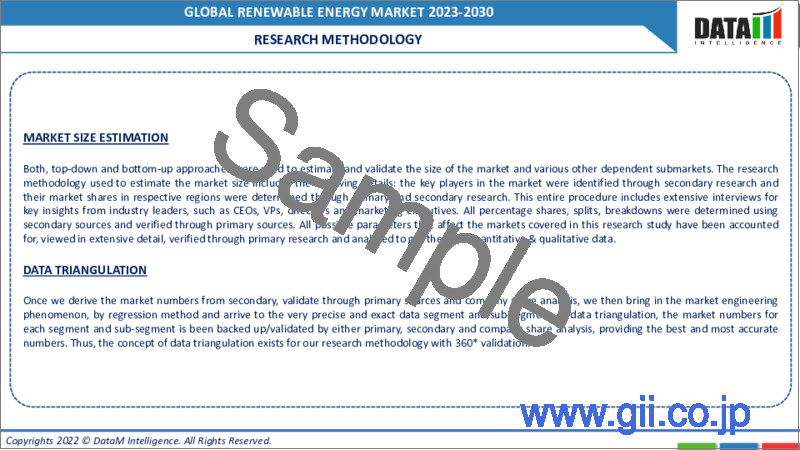|
|
市場調査レポート
商品コード
1304486
再生可能エネルギーの世界市場-2023年~2030年Global Renewable Energy Market - 2023-2030 |
||||||
カスタマイズ可能
適宜更新あり
|
|||||||
| 再生可能エネルギーの世界市場-2023年~2030年 |
|
出版日: 2023年07月07日
発行: DataM Intelligence
ページ情報: 英文 192 Pages
納期: 即日から翌営業日
|
- 全表示
- 概要
- 目次
市場概要
世界の再生可能エネルギー市場は、2022年に1兆1,000億米ドルに達し、2030年には2兆米ドルに達すると予測され、予測期間2023-2030年のCAGRは8.4%で成長します。世界の再生可能エネルギー市場の成長を促進する主な要因の一つは、新興国政府が再生可能エネルギーでエネルギー需要の増加を満たすために採用している政策です。
再生可能エネルギー技術、特に太陽光発電(PV)や風力発電のコストが低下していることが、市場成長の原動力となっています。技術の進歩、規模の経済、製造プロセスの改善、競争の激化が大幅なコスト削減につながり、再生可能エネルギーは経済的に実行可能で、従来のエネルギー源と競争力を持つようになっています。
有利な政府政策、規制と政策は、再生可能エネルギー市場の成長を促す上で重要な役割を果たしています。固定価格買取制度、税額控除、再生可能エネルギー・ポートフォリオ基準、ネットメータリングは、財政的インセンティブと規制上の支援を提供することによって再生可能エネルギーの導入を奨励する政策です。
市場力学
エネルギー安全保障への関心の高まり
エネルギー安全保障には、化石燃料への依存を減らすことが含まれます。化石燃料は有限な資源であり、価格変動や地政学的リスクの影響を受けやすいです。北米や欧州などの先進諸国の多くは、国家安全保障戦略の重要な一部として、エネルギー自給の実現にますます力を入れるようになっています。
太陽光、風力、水力、地熱、バイオエネルギーなどの再生可能エネルギーは、エネルギーミックスを多様化し、発電における化石燃料への依存度を下げます。再生可能エネルギーに移行することで、化石燃料の輸入に関連する燃料価格の変動、供給の途絶、地政学的緊張に対する脆弱性を減らし、エネルギー安全保障を強化することができます。
欧州諸国は、欧州のエネルギー価格の大幅な上昇を引き起こしたロシア・ウクライナ戦争の余波を受け、地政学的緊張の中でロシアへの依存を解消しようと、エネルギー自給を確保する努力を強めてきました。2022年5月、EUはエネルギー供給を多様化し、クリーンエネルギー発電を増加させるため、REPowerEUパッケージを開始しました。この箱は、太陽光発電容量を4,100万kW、風力発電容量を1,600万kW増加させるのに役立っています。
企業の持続可能性への取り組みの増加
多くの企業や法人が、環境への影響を減らし、社会的イメージを高めるために、持続可能性の目標を採用し、再生可能エネルギーの調達に取り組んでいます。企業は、再生可能エネルギーの企業向け電力購入契約(PPA)や、複数のプロセスにおけるグリーン認証など、さまざまな対策を講じています。
工場やオフィスの電力を完全に再生可能エネルギーで賄うため、太陽光発電所や風力発電所を設置した企業もあります。企業需要の急増は、再生可能エネルギー・プロジェクトへの投資に拍車をかけ、この分野の技術革新を促進しています。エネルギー発電会社は、再生可能エネルギーの採用を増やすために、企業とパートナーシップを結んでいます。
再生可能エネルギー事業に対する地元の反対
地元の反対は、NIMBY主義(Not In My Backyard)現象によって生じることが多いです。個人や地域社会は一般的に再生可能エネルギーのコンセプトを支持するが、自宅や地域社会の近くにある特定のプロジェクトには反対します。騒音、視覚的影響、土地利用、資産価値への潜在的影響などに関する懸念が、発展途上国や先進国における再生可能エネルギー開発に対する抵抗につながっています。
コミュニティは、意思決定プロセスから排除されていると感じたり、プロジェクトに関連する経済的利益や雇用機会が地域住民に十分に分配されていないと考えたりします。そのため、政府は土地取得において様々なハードルに直面し、それがプロジェクトコストの上昇につながり、特定の地域における将来のプロジェクトの規模拡大に直接影響を与えます。
COVID-19の影響分析
COVID-19の流行は、再生可能エネルギー部門に課題と機会の両方をもたらしました。一方では、封鎖措置、サプライチェーンの混乱、経済の不確実性が、再生可能エネルギー市場におけるプロジェクトの遅延、投資の減少、一時的な後退をもたらしました。電力需要の減少とエネルギーシステムの混乱は、再生可能エネルギーの導入に影響を与えました。
しかし、世界各国の政府は、景気回復や景気刺激策におけるクリーンエネルギーの重要性を認識し、再生可能エネルギープロジェクトに対する支援の増加につながっています。さらに、パンデミックは再生可能エネルギー源の回復力と信頼性を浮き彫りにし、長期的な見通しをさらに強化しました。
AIの影響
人工知能は、業務を最適化し、効率を高め、意思決定を改善することで、再生可能エネルギー部門に革命をもたらしています。AIアルゴリズムは、再生可能エネルギー発電の予測、エネルギー貯蔵システムの最適化、スマートグリッドにおけるエネルギー管理の自動化に使用されています。AIを統合することで、再生可能エネルギーの断続的な性質の影響を緩和することができます。
また、AIは予知保全を可能にし、ダウンタイムを減らし、資産パフォーマンスを向上させる。再生可能エネルギー事業者は、AI技術を活用することで、事業の信頼性と費用対効果を高め、世界のエネルギーミックスにおける再生可能エネルギーの成長と統合を促進することができます。これは、太陽エネルギーのようなエネルギー貯蔵に依存するシステムにとって有益です。
ウクライナ・ロシアの影響
ウクライナ・ロシア戦争と地政学的緊張は、世界の再生可能エネルギー市場に直接影響を与えます。紛争によってエネルギーのサプライチェーンが寸断され、エネルギー安全保障に対する懸念が高まっています。その結果、各国は国内の再生可能エネルギー資源を優先し、化石燃料の輸入依存度を下げる可能性があります。
その結果、風力や太陽光などの再生可能エネルギー・プロジェクトへの投資が増加し、エネルギー貯蔵技術も進歩する可能性があります。さらに、地政学的な不確実性が、不安定なエネルギー市場への依存を減らすために、再生可能エネルギーへの国際的な協力や投資を促進するかもしれないです。戦争は、特に欧州諸国において再生可能エネルギーへの移行を加速させると予想されます。
目次
第1章 調査手法と調査範囲
第2章 定義と概要
第3章 エグゼクティブサマリー
第4章 市場力学
- 影響要因
- 促進要因
- エネルギー安全保障への関心の高まり
- 企業の持続可能性への取り組みの増加
- スマートグリッド技術の採用拡大
- 社会意識と消費者需要の高まり
- 抑制要因
- 再生可能エネルギー・プロジェクトに対する地元の反対
- 化石燃料補助金による市場の歪み
- 機会
- 影響分析
- 促進要因
第5章 産業分析
- ポーターのファイブフォース分析
- サプライチェーン分析
- 価格分析
- 規制分析
第6章 COVID-19分析
第7章 タイプ別
- 水力エネルギー
- 太陽エネルギー
- 太陽電池パネル
- 太陽電池ガラス
- 薄膜太陽電池
- その他
- 風力エネルギー
- 陸上
- オフショア
- 地熱エネルギー
- バイオエネルギー
- その他
第8章 エンドユーザー別
- 商業
- 住宅
- 産業
第9章 地域別
- 北米
- 米国
- カナダ
- メキシコ
- 欧州
- ドイツ
- 英国
- フランス
- イタリア
- スペイン
- その他欧州
- 南米
- ブラジル
- アルゼンチン
- その他南米
- アジア太平洋
- 中国
- インド
- 日本
- オーストラリア
- その他アジア太平洋地域
- 中東・アフリカ
第10章 競合情勢
- 競合シナリオ
- 市況/シェア分析
- M&A分析
第11章 企業プロファイル
- Acciona Energia
- 会社概要
- 製品ポートフォリオと説明
- 財務概要
- 主な発展
- EDF Renewables
- Vestas
- Ørsted A/S
- First Solar
- Adani Green Energy
- Tata Power
- Duke Energy Corporation
- Iberdrola, S.A.
- NextEra Energy, Inc.
第12章 付録
Market Overview
The Global Renewable Energy Market reached US$ 1.1 trillion in 2022 and is expected to reach US$ 2.0 trillion by 2030, growing with a CAGR of 8.4% during the forecast period 2023-2030. One of the major factors in driving Global Renewable Energy Market growth is the policy adopted by governments of emerging countries to fulfill rising energy demand with renewable energy.
The declining costs of renewable energy technologies, particularly solar photovoltaic (PV) and wind power, have driven market growth. Technological advancements, economies of scale, improved manufacturing processes and increased competition have led to significant cost reductions, making renewable energy more economically viable and competitive with conventional energy sources.
Favorable government policies, regulations and incentives play a crucial role in stimulating the growth of the renewable energy market. Feed-in tariffs, tax credits, renewable portfolio standards and net metering are policies that encourage renewable energy adoption by providing financial incentives and regulatory support.
Market Dynamics
Increasing Focus on Energy Security
Energy security involves reducing dependence on fossil fuels, which are finite resources and subject to price volatility and geopolitical risks. Many countries in the developed regions, such as North America and Europe, have become increasingly focused on achieving energy independence as a key part of their national security strategies.
Renewable energy sources, such as solar, wind, hydro, geothermal and bioenergy, diversify the energy mix, reducing reliance on fossil fuels for electricity generation. By transitioning to renewable energy, countries can enhance their energy security by decreasing vulnerability to fuel price fluctuations, supply disruptions and geopolitical tensions related to fossil fuel imports.
European countries have increased efforts to secure energy independence in the aftermath of the Russia-Ukraine war which caused a massive increase in European energy prices and European nations sought to remove dependence on Russia at a time of geopolitical tensions. In May 2022, the EU launched the REPowerEU package to diversify energy supplies and increase clean energy generation. The box has helped to increase solar energy capacity by 41 GW and wind energy capacity by 16 GW.
Increasing Corporate Sustainability Initiatives
Many businesses and corporations are adopting sustainability goals and committing to renewable energy procurement to reduce their environmental impact and enhance their public image. Corporations have undertaken various measures, including corporate power purchase agreements (PPAs) for renewable energy and green certifications for multiple processes.
Some corporations have set up solar and wind energy power plants to ensure that their factories and offices are completely powered by renewable energy. The surge in corporate demand is spurring investments in renewable energy projects, driving innovation in the sector. Energy generation companies are entering into partnerships with corporates to increase adoption of renewable energy.
Local Opposition to Renewable Energy Projects
Local opposition often arises due to the NIMBYism (Not In My Backyard) phenomenon, where individuals and communities generally support the concept of renewable energy but object to specific projects located near their homes or communities. Concerns related to noise, visual impact, land use and potential effects on property values have led to resistance against renewable energy developments in developing and developed countries.
Communities may feel excluded from decision-making processes or believe that the economic benefits and job opportunities associated with the projects are not adequately distributed among local residents. Governments, therefore, face various hurdles in land acquisition, which leads to rising project costs and directly impacts the scaling up of future projects in a particular region.
COVID-19 Impact Analysis
The COVID-19 pandemic has brought both challenges and opportunities for the renewable energy sector. On the one hand, lockdown measures, supply chain disruptions and economic uncertainties led to project delays, reduced investments and temporary setbacks in the renewable energy market. The decline in electricity demand and disruptions to energy systems affected renewable energy deployment.
However, governments worldwide recognized the importance of clean energy in economic recovery and stimulus packages, leading to increased support for renewable energy projects. Additionally, the pandemic highlighted the resilience and reliability of renewable energy sources, further strengthening their long-term prospects.
AI Impact
Artificial intelligence is revolutionizing the renewable energy sector by optimizing operations, enhancing efficiency and improving decision-making. AI algorithms are used to forecast renewable energy generation, optimize energy storage systems and automate energy management in smart grids. Integrating AI can help mitigate the impact of the intermittent nature of renewable energy.
AI also enables predictive maintenance, reducing downtime and improving asset performance. By leveraging AI technology, renewable energy operators can increase the reliability and cost-effectiveness of their operations, driving the growth and integration of renewable energy into the global energy mix. It is beneficial for energy storage-dependent systems, such as solar energy.
Ukraine-Russia Impact
The Ukraine-Russia war and geopolitical tensions directly affect the global renewable energy market. The conflict has disrupted energy supply chains and raised concerns about energy security. As a result, countries may prioritize domestic renewable energy resources and reduce dependence on fossil fuel imports.
It could lead to increased investments in renewable energy projects, such as wind and solar, as well as advancements in energy storage technologies. Additionally, geopolitical uncertainties may drive international collaborations and investments in renewable energy to reduce reliance on volatile energy markets. The war is expected to accelerate the transition to renewable energy, especially in European countries.
Segment Analysis
The Global Renewable Energy Market is segmented based on type, end-user and region.
Favorable Policies Propel the Growth of Renewable Energy for Residential End-User
The adoption of renewable energy for residential purposes has increased significantly in recent years, mainly because of growing awareness about the impact of climate change. Residential solar photovoltaic (PV) systems are one of the most popular and widely adopted renewable energy technologies among homeowners.
Solar PV systems convert sunlight into electricity using photovoltaic panels installed on rooftops or open spaces. Homeowners can generate clean and sustainable electricity on-site, reducing their reliance on grid power and lowering their carbon footprint. . Home energy management systems enable homeowners to monitor and optimize their energy consumption, ensuring efficient use of renewable energy.
Favorable government policies also play a major role in adoption of residential renewable energy solutions. For instance, the U.S. government provided a 26% federal tax credit for systems installed till 2022. In late 2022, the rule was amended to increase the effective federal tax credit to 30% for systems installed between 2023 and 2032.
Geographical Analysis
North America Occupies A Significant Share in the Global Market
Solar power has witnessed remarkable growth in North America. The region benefits from ample sunlight, technological advancements , and declining solar photovoltaic (PV) systems costs. U.S. and Canada have made substantial investments in utility-scale solar projects and rooftop solar installations. Solar farms and community solar initiatives have gained popularity, allowing residents and businesses to benefit from solar energy without installing panels on their own properties.
North America has significant offshore renewable energy potential, particularly in coastal regions. Offshore wind farms have started gaining momentum, with projects underway in U.S. For instance, in May 2023, construction commenced on a new offshore wind farm with a capacity of 2.4 GW off the coast of New Bedford, Massachusetts, U.S.
Hydropower has long been a dominant renewable energy source in North America. Canada and U.S. have many hydroelectric power plants, both large and small-scale. The region benefits from abundant water resources and an extensive existing hydropower infrastructure. For instance, in April 2023, the New England Connect Project linking hydropower from Quebec in Canada to the northeastern U.S. received the go-ahead from regulatory authorities.
Competitive Landscape
The major global players include: Acciona Energia, EDF Renewables, Vestas, Ørsted A/S, First Solar, Adani Green Energy, Tata Power, Duke Energy Corporation, Iberdrola, S.A. and NextEra Energy, Inc.
Why Purchase the Report?
- To visualize the Global Renewable Energy Market segmentation based on type, end-user and region, as well as understand key commercial assets and players.
- Identify commercial opportunities by analyzing trends and co-development.
- Excel data sheet with numerous renewable energy market-level data points with all segments.
- PDF report consists of a comprehensive analysis after exhaustive qualitative interviews and an in-depth study.
- Product mapping available as Excel consisting of key products of all the major players.
The Global Renewable Energy Market Report Would Provide Approximately 53 Tables, 50 Figures And 192 Pages.
Target Audience 2023
- Manufacturers/ Buyers
- Industry Investors/Investment Bankers
- Research Professionals
- Emerging Companies
Table of Contents
1. Methodology and Scope
- 1.1. Research Methodology
- 1.2. Research Objective and Scope of the Report
2. Definition and Overview
3. Executive Summary
- 3.1. Snippet by Type
- 3.2. Snippet by End-User
- 3.3. Snippet by Region
4. Dynamics
- 4.1. Impacting Factors
- 4.1.1. Drivers
- 4.1.1.1. Increasing Focus on Energy Security
- 4.1.1.2. Increasing Corporate Sustainability Initiatives
- 4.1.1.3. Growing Adoption of Smart Grid Technology
- 4.1.1.4. Increasing Public Awareness and Consumer Demand
- 4.1.2. Restraints
- 4.1.2.1. Local Opposition to Renewable Energy Projects
- 4.1.2.2. Fossil Fuel Subsidies Creating Market Distortion
- 4.1.3. Opportunity
- 4.1.4. Impact Analysis
- 4.1.1. Drivers
5. Industry Analysis
- 5.1. Porter's Five Force Analysis
- 5.2. Supply Chain Analysis
- 5.3. Pricing Analysis
- 5.4. Regulatory Analysis
6. COVID-19 Analysis
- 6.1. Analysis of COVID-19
- 6.1.1. Scenario Before COVID
- 6.1.2. Scenario During COVID
- 6.1.3. Scenario Post COVID
- 6.2. Pricing Dynamics Amid COVID-19
- 6.3. Demand-Supply Spectrum
- 6.4. Government Initiatives Related to the Market During Pandemic
- 6.5. Manufacturers Strategic Initiatives
- 6.6. Conclusion
7. By Type
- 7.1. Introduction
- 7.1.1. Market Size Analysis and Y-o-Y Growth Analysis (%), By Type
- 7.1.2. Market Attractiveness Index, By Type
- 7.2. Hydroelectric Energy*
- 7.2.1. Introduction
- 7.2.2. Market Size Analysis and Y-o-Y Growth Analysis (%)
- 7.3. Solar Energy
- 7.3.1. Solar Panel
- 7.3.2. Solar Photovoltaic Glass
- 7.3.3. Thin Film Solar Cell
- 7.3.4. Others
- 7.4. Wind Energy
- 7.4.1. On-shore
- 7.4.2. Off-shore
- 7.5. Geothermal Energy
- 7.6. Bioenergy
- 7.7. Others
8. By End-User
- 8.1. Introduction
- 8.1.1. Market Size Analysis and Y-o-Y Growth Analysis (%), By End-User
- 8.1.2. Market Attractiveness Index, By End-User
- 8.2. Commercial*
- 8.2.1. Introduction
- 8.2.2. Market Size Analysis and Y-o-Y Growth Analysis (%)
- 8.3. Residential
- 8.4. Industrial
9. By Region
- 9.1. Introduction
- 9.1.1. Market Size Analysis and Y-o-Y Growth Analysis (%), By Region
- 9.1.2. Market Attractiveness Index, By Region
- 9.2. North America
- 9.2.1. Introduction
- 9.2.2. Key Region-Specific Dynamics
- 9.2.3. Market Size Analysis and Y-o-Y Growth Analysis (%), By Type
- 9.2.4. Market Size Analysis and Y-o-Y Growth Analysis (%), By End-User
- 9.2.5. Market Size Analysis and Y-o-Y Growth Analysis (%), By Country
- 9.2.5.1. The U.S.
- 9.2.5.2. Canada
- 9.2.5.3. Mexico
- 9.3. Europe
- 9.3.1. Introduction
- 9.3.2. Key Region-Specific Dynamics
- 9.3.3. Market Size Analysis and Y-o-Y Growth Analysis (%), By Type
- 9.3.4. Market Size Analysis and Y-o-Y Growth Analysis (%), By End-User
- 9.3.5. Market Size Analysis and Y-o-Y Growth Analysis (%), By Country
- 9.3.5.1. Germany
- 9.3.5.2. The UK
- 9.3.5.3. France
- 9.3.5.4. Italy
- 9.3.5.5. Spain
- 9.3.5.6. Rest of Europe
- 9.4. South America
- 9.4.1. Introduction
- 9.4.2. Key Region-Specific Dynamics
- 9.4.3. Market Size Analysis and Y-o-Y Growth Analysis (%), By Type
- 9.4.4. Market Size Analysis and Y-o-Y Growth Analysis (%), By End-User
- 9.4.5. Market Size Analysis and Y-o-Y Growth Analysis (%), By Country
- 9.4.5.1. Brazil
- 9.4.5.2. Argentina
- 9.4.5.3. Rest of South America
- 9.5. Asia-Pacific
- 9.5.1. Introduction
- 9.5.2. Key Region-Specific Dynamics
- 9.5.3. Market Size Analysis and Y-o-Y Growth Analysis (%), By Type
- 9.5.4. Market Size Analysis and Y-o-Y Growth Analysis (%), By End-User
- 9.5.5. Market Size Analysis and Y-o-Y Growth Analysis (%), By Country
- 9.5.5.1. China
- 9.5.5.2. India
- 9.5.5.3. Japan
- 9.5.5.4. Australia
- 9.5.5.5. Rest of Asia-Pacific
- 9.6. Middle East and Africa
- 9.6.1. Introduction
- 9.6.2. Key Region-Specific Dynamics
- 9.6.3. Market Size Analysis and Y-o-Y Growth Analysis (%), By Type
- 9.6.4. Market Size Analysis and Y-o-Y Growth Analysis (%), By End-User
10. Competitive Landscape
- 10.1. Competitive Scenario
- 10.2. Market Positioning/Share Analysis
- 10.3. Mergers and Acquisitions Analysis
11. Company Profiles
- 11.1. Acciona Energia*
- 11.1.1. Company Overview
- 11.1.2. Product Portfolio and Description
- 11.1.3. Financial Overview
- 11.1.4. Key Developments
- 11.2. EDF Renewables
- 11.3. Vestas
- 11.4. Ørsted A/S
- 11.5. First Solar
- 11.6. Adani Green Energy
- 11.7. Tata Power
- 11.8. Duke Energy Corporation
- 11.9. Iberdrola, S.A.
- 11.10. NextEra Energy, Inc.
LIST NOT EXHAUSTIVE
12. Appendix
- 12.1. About Us and Services
- 12.2. Contact Us





